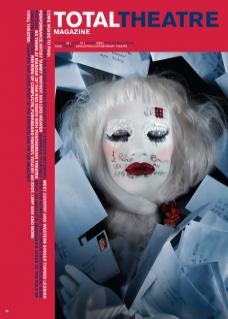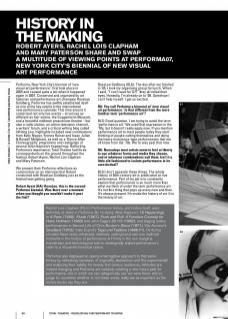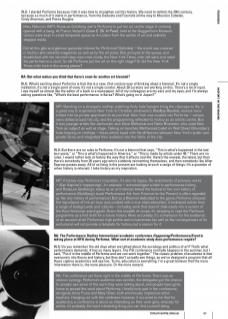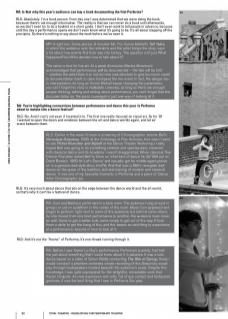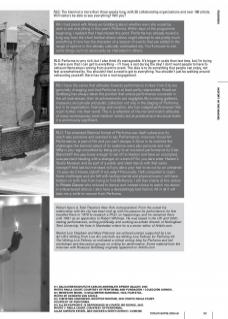Performa, New York City’s biennial of ‘new visual art performance’, first took place in 2005 and caused quite a stir when it happened again in 2007. Conceived and organized by art historian and performance art champion RoseLee Goldberg, Performa has swiftly established itself as one of the key events in the international new performance calendar. This time around it comprised not only live events – at venues as different as hair salons, the Guggenheim Museum, and a beautiful midtown proscenium theatre – but also a radio station, an online television channel, a writers’ forum, and a critical writing blog called Writing Live. Highlights included new commissions from Kelly Nipper, Yvonne Rainer and Isaac Julien & Russell Maliphant, as well as a ‘Dance After Choreography’ programme and restagings of several Allan Kaprow’s happenings. Reflecting Performa’s importance, Total Theatre had three correspondents on the ground throughout the festival, Robert Ayers, Rachel Lois Clapham and Mary Paterson.
We present their Performa reflections as commentary on an interview that Robert conducted with RoseLee Goldberg just as the festival was getting going.
Robert Ayers (RA): RoseLee, this is the second Performa biennial. Was there ever a moment when you thought you wouldn’t make it past the first?
RoseLee Goldberg (RLG): The day after we finished in ’05, I took my organising group for lunch. When I said, “I can’t wait for ’07!” they all rolled their eyes. Honestly, I’m already on to ’09. Somehow I can’t help myself. I get so excited.
RA: You call Performa a biennial of ‘new visual art performance.’ Is that different from the more familiar term ‘performance art’?
RLG: Good question. I am trying to avoid the term ‘performance art.’ We used that expression in the ’70s, but it doesn’t really apply now. If you mention performance art to most people today they start thinking of people cutting themselves and doing the heavy endurance-type performances that we all know from the ’70s. We’re way past that now.
RA: Nowadays most artists seem to feel at liberty to use whatever forms and media they choose, and in whatever combinations suit them. Isn’t it a little old-fashioned to isolate performance in its own festival?
RLG:I don’t separate these things. The whole history of 20th-century art is predicated on live performance. Part of my job is to constantly explain that performance is so much more than what we think of under the term performance art. It’s not this thing that pops up every now and then. It’s always present. It’s inside the history of art. It is the history of art.
Rachel Lois Clapham (RLC): Performance history, and history itself, were definitely at stake in Performa. By ‘re-doing’ Allan Kaprow’s 18 Happenings in 6 Parts (1959), Fluids (1967), Push and Pull: A Furniture Comedy for Hans Hofmann (1963) and John Cage’s 33 1/3 (1969), and staging online performances in Second Life of Chris Burden’s Shoot (1971), Vito Acconci’s Seedbed (1972), Valie Export’s Tapp und Tastkino (1968-71), Performa situated these rarely witnessed, relatively underground and now mythical moments in the history of performance art firmly in the non marginal, mainstream and technological and so strategically staked performance’s claim to a Visual Art historical canon.
Performa also displayed an openly interrogative approach to that same history by refreshing narratives of originality, abstraction and ‘the experimental’ and analysing their validity for twenty first century audiences. Attitudes are indeed changing and Performa are certainly creating a new future past for performance, one in which we can categorically say ‘we were there’ and so judge for ourselves whether or not these works really are as important as the history books say they are.
RLG: I started Performa because I felt it was time to straighten out this history. We need to rethink the 20th century, because so much of it starts in performance, from the Dadaists and Futurists all the way to Maurizio Cattelan, Cindy Sherman, and Pierre Huyghe.
Mary Paterson (MP): RoseLee Goldberg wants Performa to put live art centre stage. It certainly opened with a bang. At Franco Vezzoli’s Cose E (Si Vi Pare), held at the Guggenheim Museum, visitors were kept in a bad tempered queue as A-Listers from the worlds of art and celebrity stepped inside.
Did all this glitz and glamour generate interest for Performa? Definitely – the event was covered in fashion and celebrity magazines as well as by the art press. But, annoyed at the queue, and dissatisfied with her second-class view once inside, the New York Times critic left early and rated the performance a stunt. So did Performa put live art on the right stage? Or did the New York Times critic look in the wrong places?
RA: But what makes you think that there’s room for another art biennial?
RLG: What’s exciting about Performa is that this is a new, 21st-century way of thinking about a biennial. It’s not a single institution, it’s not a single point of view, it’s not a single curator. About 20 curators are working on this. There’s a lot of input. I see myself as almost like the editor of a book or a newspaper. All of my colleagues are my ears and my eyes, and I’m always asking questions like, “What’s the best performance in Korea? What’s going on in Japan?”
MP: Standing on a stranger’s rooftop, watching thirty hula-hoopers bring the cityscape to life, is a great way to experience New York. In Christian Jankowski’s Rooftop Routine, viewers were invited into his private apartment to do just that. New York was curated into Performa – venues were dotted around the city, and the programming reflected its history as an artistic centre. But it was younger artists like Jankowski, also Dave McKenzie and Pablo Bronstein, who used New York as subject as well as stage. Talking on benches (McKenzie), ballet on Wall Street (Bronstein), hula-hooping on rooftops – these artists toyed with the difference between New York’s public and private faces, and integrated their audience into the fabric of the city.
RLG: But there are no rules to Performa. It’s not a biennial that says, “This is what’s happened in the last two years,” or “This is what’s happened in America,” or “This is made by artists under 40.” There are no rules. I would rather look at history the way that it affects real life: there’s the newest, the latest, but then there’s somebody from 20 years ago who’s suddenly reinventing themselves, and then somebody like Allan Kaprow passes away. All of us living in the present are looking at such a range of things. It’s a question of when history is relevant. I take history as my inspiration.
MP: If history was Performa’s inspiration, it’s also its legacy. Re-enactments of previous works – Alan Kaprow’s ‘happenings’, for example – acknowledged a debt to performance history, and RoseLee Goldberg’s status as an art historian linked the festival to her own history of performance. (Goldberg’s book Performance Art: from Futurism to the Present is often regarded as the only history of performance.) But as a Biennial dedicated to the genre, Performa stressed the importance of live art now; and, curated with a true internationalism, it embraced artists from a range of backgrounds and cultures – including work that doesn’t slide easily into a version of the Euro-American avant-garde. Given this breadth of scope, it’s tempting to read the Performa programme as a first draft for a future history. More accurately, it’s a champion for the existence of an account at all. Performa’s high profile and inclusiveness (as well as the consequences of its exclusions) will not provide a template for history, but a reason for it.
RA: The Performance Studies International academic conference Happening/Performance/Event is taking place at NYU during Performa. What sort of academic study does performance require?
RLG: Do you remember the old days when we talked about the sociology and politics of art? That’s what performance demands. It has so many layers. The PSI conference normally happens in the summer, but I said, “Put it in the middle of Performa and we can work together.” The classic problem of academia is that everyone’s into theory and history, but they don’t actually see things, so we’ve designed a program that all those captive academics will see live. To me, education is everything. I’m a great believer that the more information there is, the more pleasure. Or the more reward.
RA: The conference sat there right in the middle of Performa. There was an obvious synergy: Performa’s audience was swollen, the delegates got the chance to actually see some of the work they were talking about, and people have gone home to spread the word about Performa. I briefly took part in the conference, alongside Anna Furse and Mary Oliver, both enormously impressive artist-teachers. Hanging out with the conferees however, it occurred to me that for academics, a conference is about as interesting as their work gets, whereas for artists, it’s probably the least interesting thing you can find yourself doing.
RA: Is that why this year’s audience can buy a book documenting the first Performa?
RLG: Absolutely. I’m a book person. From day one I was determined that we were doing the book, because there’s not enough information. The reality is that we can never do a book until afterwards, so we don’t even try to do a booklet or a short guide. I don’t even want to tell people in advance, because until the day a performance opens we don’t even know what it’s going to be. It’s all about stepping off the precipice. So there’s nothing to say about the work before we’ve seen it.
MP: A light box. Some photos. 8 minutes flat. Tris Vonna Michell’s Tall Tales, in which the audience sets the restraints and the artist brings the story, says a lot about how events find their way into history. The question isn’t just What happened? but Who decides how to talk about it?
The same is true for live art. At a panel discussion Marina Abramovic acknowledged that performance will be documented – the tale will be told – whether the artist likes it or not, but she was reluctant to give too much credit to documentation itself, in case it eclipses the live event. In fact, the danger lies in interpretation. As long as Vonna Michell keeps changing the parameters, you can’t forget his story is malleable. Likewise, as long as there are enough people thinking, talking and writing about performance, you can’t forget that the documentation (or the press coverage) is just one way of looking at it.
RA: You’re highlighting connections between performance and dance this year. Is Performa about to mutate into a dance festival?
RLG: No. And it can’t, not even if I wanted it to. The first one really focused on visual art. So for ’07 I wanted to open the doors and windows between the art and dance worlds again, and let air move between them.
RLC: Earlier in the week I’d seen a screening of Choreographer Jerome Bell’s Veronique Doisneau, 2005 at the Anthology of Film Archives. And when I went to see Pichet Klunchen and Myself at the Dance Theater Workshop, I really hoped Bell was going to do something similarly and spectacularly irreverent with classical dance and its Academy. I wasn’t disappointed. When classical Thai Dancer Klunchen asked Bell to show us ‘what kind of dance he did’ Bell put on David Bowie’s 1983 hit ‘Let’s Dance’ and casually got his middle-aged groove on in a genuine dad-style disco shuffle. And that was it. Bell’s renegade daddance on the grave of the tradition, skill and training of modern and classical dance. It was one of my favourite moments in Performa and a piece of ‘Dance After Choreography’ joy.
RLG: It’s very much about dance that sits on the edge between the dance world and the art world, so that’s why it can’t be a festival of dance.
RA: Cool and Balducci performed in a bare room. The audience hung around in groups or sat on a platform in the center of the room. Marie Cool appeared and began to perform: right next to some of the audience, but behind some others. As she moved from one brief performance to another, the audience must move as well. Some to get a better look, some simply to get out of the way. It took them a while to get the hang of this, and this seems an odd thing to experience at a performance: lessons in how to look at it.
RLG: And it’s not the “theme” of Performa; it’s one thread running through it.
RA: Before I saw Xavier Le Roy’s performance, Performa’s publicity had told me just about everything that I could know about it in advance. It was a solo dance based on a video of Simon Rattle conducting The Rite of Spring; Xavier would ‘conduct’ a phantom orchestra whose recording of the Stravinsky would play through loudspeakers located beneath the audience’s seats. Despite this knowledge, I was quite unprepared for the delightful, remarkable work that Xavier conjured. At once expressive and witty, full of eye contact and fantasized gestures, it was the best thing that I saw in Performa this year.
RLG: The biennial is more than three weeks long, with 30 collaborating organizations and over 100 artists. Will visitors be able to see everything? Will you?
RA: I had joked with RoseLee Goldberg about whether even she would be able to see everything in this year’s Performa. Within days of the programme beginning, I realized that I had missed the point. Performa has already moved a long way from the short festival where visitors might attempt to see pretty much everything. It now has the character of a season of events that are added to the range of options in this already culturally overloaded city. You’ll choose to see some things, but not necessarily be interested in others.
RLG: Performa is very rich, but I also think it’s manageable. It’s bigger in scale than last time, but I’m trying to make sure that I can get to everything – if I have a rest during the day! I don’t want people to have to exhaust themselves running from event to event. The idea is to do something that people can enjoy, not feel overwhelmed by. You shouldn’t feel a need to get to everything. You shouldn’t just be walking around exhausting yourself; there has to be a real engagement.
RA: I have the sense that attitudes towards performance in New York City are genuinely changing, and that Performa is at least partly responsible. RoseLee Goldberg has always taken the position that unless performance succeeds in the art mainstream, then its achievements are negligible. By involving galleries, museums, and private and public collectors not only in the staging of Performa, but in its organization, financing, and curation, she has nudged performance that much further into their world. This is a reflection of the mix-and-match attitudes of many contemporary ‘post-medium’ artists, but at practical and structural levels it is enormously significant.
RLC: The extended Biennial format of Performa was itself subversive; its reach was pervasive and seemed to say Performance, moreover Visual Art Performance, is part of life and you can’t escape it. Once in its clutches the challenges the biennial asked of its audience were also personal and real; Why is your ego smoothed by being privy to an exclusive performance by Cate Blanchett? Are you brave enough to set off to Harlem and have an unscripted, unsupervised meeting with a stranger on a bench? Do you dare enter Harlem’s Studio Museum and be part of a public and silent dance with that same stranger? And last but not least, will you allow your hair to be cut by an untrained 12-year-old Chinese stylist? If not, why? Personally, I felt compelled to meet these challenges and am left with lasting mental and physical scars; I still have blisters on both feet from trying to find McKenzie. I still feel shame at the visitors to Private Dancer who refused to dance, and instead chose to watch me dance in embarrassed silence. I also have a devastatingly bad haircut. All in all it will take me a while to recover from Performa.
Robert Ayers is Total Theatre’s New York correspondent. From the outset his relationship with the city has been tied up with his passion for performance: he first travelled there in 1979 to research a Ph.D. on happenings, and he remained there until 1981 as an apprentice to Robert Whitman. He was based in the UK until 2001, making performances, writing prolifically, and working as artistic director of Nottingham Trent University. He lives in Manhattan where he is a senior editor of Artinfo.com.
Rachel Lois Clapham and Mary Paterson are writers/curators supported by Live Art UK’s Writing From Live Art, and both are Writing Live Fellows for Performa 07. The Writing Live Fellows co-ordinated a critical writing blog for Performa and led workshops and discussion groups on writing for performance. Some material from the interview with RoseLee Goldberg originally appeared on Artinfo.com
